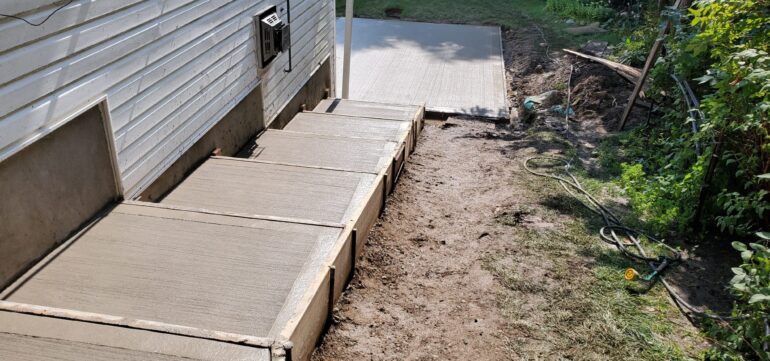
Concrete Stairs
Design and Planning
Measurement and Calculation
Determine the total rise (the vertical height between the two levels) and the total run (the horizontal distance). These measurements are critical for calculating the number of steps needed and the dimensions of each step (riser height and tread depth).
Riser and Tread
The riser is the vertical portion of the step, while the tread is the horizontal part where you step. The typical riser height is about 7 inches, and the typical tread depth is about 11 inches, but these can vary based on design requirements and local building codes.
Width and Landing
The width of the stairs should accommodate the expected traffic and meet local building codes. Landings may be required for longer staircases, typically after every 12 feet of vertical rise, to provide a resting place and make the stairs safer.
Handrails and Guardrails
For safety, stairs with more than a few steps should have handrails, and open sides of the stairs should have guardrails. The design and placement of these elements should comply with local building codes.
Materials
Besides the concrete, materials needed include reinforcing bars (rebar) or wire mesh to strengthen the concrete, wooden forms to shape the stairs, and possibly stone, tile, or other materials for finishing.
Before starting the project
Check for Permit requirements
Before starting any concrete project, it’s good to check with local authorities to determine if any permits are required. Regulations can vary, and compliance is important to avoid legal issues.
Landscaping
Consider landscaping around the project to enhance its visual appeal. Planting greenery along the edges or incorporating decorative elements can complement the overall design.
Maintenance and Care
Sealing
Sealing the concrete periodically helps protect it from stains, moisture penetration, and the effects of weathering. The frequency of sealing depends on factors such as climate and usage.
Expansion Joints
To minimize the risk of cracking, expansion joints should be incorporated into the concrete driveway. These joints allow for natural expansion and contraction of the concrete in response to temperature changes.